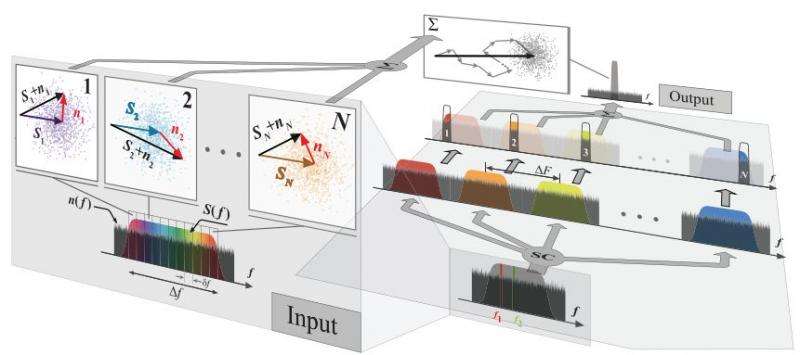Single-event noise discrimination. Credit: (c) Science 11 December 2015: Vol. 350 no. 6266 pp. 1343-1346, DOI: 10.1126/science.aac8446
(Phys.org)—A small team of researchers with the University of California has found a way to pick out a single short radio signal burst among a barrage of background noise. In their paper published in the journal Science, the team describes their technique, how it works, how accurate it is and the possible applications it might be used for. Michael Vasilyev, with the University of Texas offers a Perspectives piece on the work done by the team in the same journal issue, noting how some human organs have senses that rely on using a similar technique to make sense of the environment.
As Vasilyev notes, there are a lot of areas in science that could benefit from an ability to isolate a single short signal amongst a stream of noise—astronomy, is just one example. Currently it is impossible to separate out a unique signal if there is just one burst present—there needs to be multiple examples. That could change in the near future as the researchers on this new effort have developed a way to convert radio signals to optical signals that can be processed to filter, separate and identify individual components.
The team started with converting the radio signals to optical signals because the latter are more sensitive to changes in frequency—to make the conversation, the team looped the signals so that they could gather enough data for averaging. Next they used two tunable optical frequency combs—when the spectrums were overlapped it allowed for alignment of the components which caused the signal to be amplified as compared to other background noise, which then allowed it to be uniquely identified. The team tested their technique by running 4,720 detection attempts and found it to be better than 99 percent accurate.
The researchers believe their technique can be broadened to include the detection of a wide variety of signals, from optic applications to those that look for microwaves. It could also possibly be modified for use in seemingly unrelated research areas such as sensing the spontaneous decay of a molecule. There also exists the possibility that the new detector could be used to spot signals that to date have gone undetected, perhaps revealing the existence of some new type of phenomena.
More information: Subnoise detection of a fast random event, Science 11 December 2015: Vol. 350 no. 6266 pp. 1343-1346, DOI: 10.1126/science.aac8446
ABSTRACT
Observation of random, nonrepetitive phenomena is of critical importance in astronomy, spectroscopy, biology, and remote sensing. Heralded by weak signals, hidden in noise, they pose basic detection challenges. In contrast to repetitive waveforms, a single-instance signal cannot be separated from noise through averaging. Here, we show that a fast, randomly occurring event can be detected and extracted from a noisy background without conventional averaging. An isolated 80-picosecond pulse was received with confidence level exceeding 99%, even when accompanied by noise. Our detector relies on instantaneous spectral cloning and a single-step, coherent field processor. The ability to extract fast, subnoise events is expected to increase detection sensitivity in multiple disciplines. Additionally, the new spectral-cloning receiver can potentially intercept communication signals that are presently considered secure.
Journal information: Science
© 2015 Phys.org























